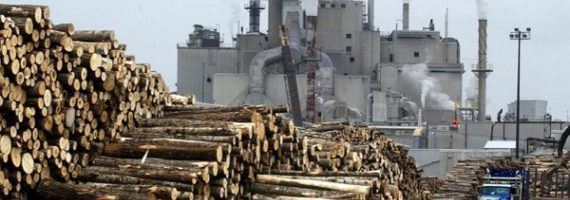International Paper – Corporate Responsibility and Raw Materials

Sustainability goals and operational changes at the world's largest paper and packaging company
International Paper (NYSE: IP) is the largest paper and packaging company in the world with revenues of over $22.4B (2015) and a current market capitalization of 17.8B. The three primary markets of International Paper are Industrial Packaging, Consumer Packaging, and Printing Papers. Given both their global footprint of manufacturing operations and their consumption of natural resources, sustainability has become a key focus area for International Paper and other companies in the paper industry over the last decade.
In 2011, International Paper announced that they were setting two key sustainability goals: a 20% reduction in absolute greenhouse gas emissions by 2020 and a 15% reduction in energy consumption by 2020. According to the company, this was going to be achieved by “increasing manufacturing efficiencies, exploring new technologies, and engaging our employees to find innovative solutions in its operations.”[i] Over the next three years, the company made significant investments in their facilities and changes to their operations to work towards these goals. International Paper released a Sustainability Overview in 2014 that highlighted some of these projects, which included: switching a South Carolina mill from using fuel oil to a cleaner natural gas in their production process (reduced greenhouse gas emissions by 30% on certain production lines) and capital investments in a Louisiana corrugator facility (reduced annual greenhouse gas emissions by 20,000 tonnes per year).[ii] In total, these projects and others have allowed International Paper to report that their greenhouse gas emissions are down 8.3% from the 2011 benchmark, which puts them almost halfway to their 2020 goal in only three years.[iii]
Despite these improvements and progress towards there 2020 goals, International Paper still has to make significant progress on their energy and greenhouse gas emissions reduction. This is such a critical mission for them, not only because of their corporate responsibility, but because the impact that greenhouse gases have on their raw material – forest. Climate change and greenhouse gases have a dramatic impact on the forest ecosystem and supply though changing temperatures and weather patterns. As the supply of these resources is continually reduced by both industry and the environment, International Paper will feel the pressure of increase raw material prices and increased regulation. In order to mitigate these pressures International Paper must continue to focus on the following areas:
- Operational and Manufacturing Efficiency Improvements – International Paper needs to improve their manufacturing process to reduce raw material waste, improve paper yields, and consume less energy throughout the production process.
- Capital Investments – International Paper needs to continue to invest in equipment upgrades and new technologies, which will both increase production efficiencies and allow for cleaner energy usage. This will be a long term benefit for the company as renewable and clean energy becomes less expensive over time, it will allow for International Paper to produce not more cost-effectively but will also allow for them to reduce their greenhouse gas emissions and impact.
If the senior leadership and directors at International Paper maintain this focused and aggressive targets of sustainability improvement, the company will not only do its part for corporate responsibility, but will help protect its key raw material resources. Ultimately, these changes, improvements, and investments will become a sustainable competitive advantage for International Paper, and as the industry leader, will set a positive example for the rest of the paper and packaging industry to follow. (614 Words)
[i] International paper announces 2020 goals to increase energy efficiency and reduce greenhouse gas emissions globally. (2011, Oct 26). PR Newswire Retrieved from http://search.proquest.com.ezp-prod1.hul.harvard.edu/docview/900499720?accountid=11311
[ii] In Our Nature: 2014 Sustainability Overview. (2015). International Paper Investor Relations Retrieved from http://www.internationalpaper.com/docs/default-source/english/sustainability/sustainability-overview-final.pdf?sfvrsn=2
[iii] In Our Nature: 2014 Sustainability Overview. (2015). International Paper Investor Relations Retrieved from http://www.internationalpaper.com/docs/default-source/english/sustainability/sustainability-overview-final.pdf?sfvrsn=2



Nice job! I lover your second regarding adapting their manufacturing processes so they can operate with cleaner energy sources. It plays well into their use of cogeneration – basically producing energy from the heat in the generators to create steam and subsequently electricity. Its a very clean source of energy and the industry has been a leader in this for some time so maybe just starting a publicity campaign so they get the recognition they deserve. Im also curious how proactive their being about increasing plant rotation times. Not sure how feasible this is, but maybe investing in seed technology that makes trees grow faster. Sounds wild but I think consumers would feel less guilty about printing if the process for replacing trees became more efficient.
Very interesting post, on a company that uniquely intersects the climate change conundrum. Given IP maintains a corporate responsibility regarding climate change, not only in terms of their own GHG emissions and energy consumption, but also because of their direct exposure to the raw materials required for their business. I wonder how the optics of their position have played a role in their public and proactive goal setting around climate change initiatives. I also wonder if next steps might include their own forest initiatives, perhaps involving tree planting. Alternatively, I wonder how much of a role IP intends to give to alternative raw materials, that can incorporate a more environmentally optimal use of raw materials. In the meantime, I will be sure to continue printing double sided.